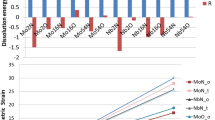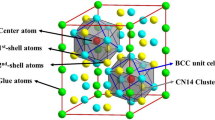Abstract
Interstitial atoms have a significant influence on the structural, thermal and electronic properties and processes in refractory metals and their alloys. In the present study, the effect of oxygen impurity on the structure of pure V, Mo and W has been studied using Density Functional Theory (DFT) calculations. Single oxygen atom has been incorporated at the tetrahedral and octahedral sites to study the structural stability. In case of V and Mo, octahedral sites are energetically favorable, whereas for W, it is the tetrahedral site; this can be explained from the calculated values of formation energies for different V-O, Mo-O and W-O systems. A bcc to bct transition has been reported in all the systems with the introduction of interstitial oxygen atoms.
Graphic abstract











Similar content being viewed by others
Data Availability Statement
This manuscript has no associated data or the data will not be deposited. [Authors’ comment: The supporting data of this study are available from the corresponding author upon reasonable request.]
References
R. Higler, S. Joris, J. Tauber, Anomalous dynamics of interstitial dopants in soft crystals. PNAS (2016). https://doi.org/10.1073/pnas.1609595113
D.R. Macfarlane, J. Huang, M. Forsyth, Lithium-doped plastic crystal electrolytes exhibiting fast ion conduction for secondary batteries. Nature 402, 792–794 (1999)
S.K. Nayak, C.J. Hung, V. Sharma, S. Pamir Alpay, A.M. Dongare, W.J. Brindley, R.J. Hebert, Insight into point defects and impurities in titanium from first principles. Comput Mater 4(11), 1–10 (2018)
J. Stráský M. Janeček P. Harcuba D. Preisler M. Landa, Biocompatible beta-Ti alloys with enhanced strength due to increased oxygen content, Titanium in Medical and Dental Applications, The Design and Manufacture of Medical Devices, Woodhead Publishing Series in Biomaterials (2018) pp 371-392
C. Ghosh, A. Singh, J. Basu, R. Divakar, E. Mohandas, Microstructural and microchemical studies of phase stability in V-O solid solution. J. Mater. Charact. 124, 129–135 (2017). https://doi.org/10.1016/j.matchar.2016.12.022
P. Erhart, A. Klein, and K. Albe, First-principles study of the structure and stability of oxygen defects in zinc oxide, Phys. Rev. B 72 (2005) 085213 1-7. https://doi.org/10.1103/PhysRevB.72.085213.s
S. Yamaoka, K. Kobayashi, K. Sueoka, J. Vanhellemont, Density functional theory study of dopant effect on formation energy of intrinsic point defects in germanium crystals. J. Cryst. Growth 474, 104–109 (2017). https://doi.org/10.1016/j.jcrysgro.2016.11.072
J. Qin, Z. Wang, D. Wang, F. Wang, X. Yan, Y. Zhong, C. Hu, H. Zhou, First-principle investigation of hydrogen solubility and diffusivity in transition metal-doped vanadium membranes and their mechanical properties. J. Alloys Compd. 805, 747–756 (2019). https://doi.org/10.1016/j.jallcom.2019.07.063
R. Joy, Z. Zhao, H.K. Xu, X. Pan, N. Liao, H. Zhou, DFT investigation of gas sensing characteristics of Au-doped vanadium dioxide. Phys. Lett. A 384, 126823 (2020). https://doi.org/10.1016/j.physleta.2020.12682
E. Mete, O. Gülseren, Ş. Ellialtıoğlu, DFT study of noble metal impurities on TiO\(_{\rm 2}\) (110). Eur. Phys. J. B 85, 1–7 (2012). https://doi.org/10.1140/epjb/e2012-21039-x
N. Zhang, Y. Zhang, Y. Yang, P. Zhang, Z. Hu, G. Changchun, Trapping of helium atom by vacancy in tungsten: a density functional theory study. Eur. Phys. J. B 90, 101 (2017). https://doi.org/10.1140/epjb/e2017-80056-1
W.J. Bowman, J. Yang, B. Yildiz, The role of doping and microstructure on hydrogen solubility in monoclinic ZrO\(_{\rm 2}\): experimental validations of simulated defect chemistry. Acta Mater. 195, 172–183 (2020). https://doi.org/10.1016/j.actamat.2020.04.020
Y. Jiang, B. Himmetoglu, M. Cococcioni, J.-P. Wang, DFT calculation and experimental investigation of Mn doping effect in Fe\(_{16}\)N\(_{2}\). AIP Adv. 6, (2016). https://doi.org/10.1063/1.4943059
S.R. Nishitani, H. Kawabe, M. Aoki, First-principles calculations on bcc-hcp transition of titanium. Mater. Sci. Eng. A 312, 77–83 (2001)
R. Li, P. Zhang, X. Li, C. Zhang, J. Zhao, First- principles study of the behavior of O, N and C impurities in vanadium solids. J. Nucl. Mater. 435, 71–76 (2013)
A. Jovanovic, A.S. Dobrota, L.D. Rafailovic, S.V. Mentus, I.A. Pasti, B. Johansson, N.V. Skorodumova, Structural and electronic properties of V\(_{2}\)O\(_{5}\) and their tuning by doping with 3D elements—modelling with DFT\(+\)U method and dispersion correction. Phys. Chem. Chem. Phys. 20, 13934–13943 (2018)
S. Tosoni, C. Di Valentin, G. Pacchioni, Effect of alkali metals interstitial doping on structural and electronic properties of WO\(_{\rm 3}\). J. Phys. Chem. C 118, 3000–3006 (2014)
L.-J. Gui, Y.-L. Liu, First-principles studying the properties of oxygen in vanadium: Thermodynamics and tensile/shear behavior. Comput. Condens. Matter 7, 7–13 (2016)
Q. Zhou, Y. Liu, W. Ju, Q. Zhang, J. Li, Exploring the effect of dopant (Si, P, S, Ge, Se, and Sb) in arsenene: a DFT study. Phys. Lett. A 384, 126146 (2020)
A. Alkhamees, Y.-L. Liu, H.-B. Zhou, S. Jin, Y. Zhang, G.-H. Lu, First-principles investigation on dissolution and diffusion of oxygen in tungsten. J. Nucl. Mater. 393, 508–512 (2009)
X.-S. Kong, Y.-W. You, Q.F. Fang, C.S. Liu, J.-L. Chen, G.-N. Luo, B.C. Pan, Z. Wang, The role of impurity oxygen in hydrogen bubble nucleation in tungsten. J. Nucl. Mater. 433, 357–363 (2013)
Q. Zhao, Z. Zhang, Y. Li, X. Ouyang, First-principles study on various point defects formed by hydrogen and helium atoms in Tungsten. Sci. Technol. Nucl. Install. 2017, 1–9 (2017)
M. Satou, K. Abe, H. Kayano, High-temperature deformation of modified V-Ti-Cr-Si type alloys. J. Nucl. Mater 179–181, 757–761 (1991)
A.F. Rowcliffe, S.J. Zinkle, D.T. Hoelzer, Effect of strain rate on the tensile properties of unirradiated and irradiated V-4Cr-4Ti. J. Nucl. Mater 283–287, 508–512 (2000)
S. Antusch, J. Reiser, J. Hoffmann, A. Onea, Refractory materials for energy applications. Energy Technol 5(7), 1064–1070 (2017). https://doi.org/10.1002/ente.201600571
J.P. Perdew, K. Burke, M. Ernzerhof, Generalized gradient approximation made simple. Phys. Rev. Lett. 77, 3865–3868 (1996). https://doi.org/10.1103/PhysRevLett.77.3865
D. Vanderbilt, Soft self-consistent pseudopotentials in a generalized eigenvalue formalism. Phys. Rev. B 41, 7892–7895 (1990). https://doi.org/10.1103/PhysRevB.41.7892
T. Fischer, J. Almlof, General methods for geometry and wave function optimization. J. Phys. Chem. 96, 9768–9774 (1992). https://doi.org/10.1021/j100203a036
K. Momma, F. Izumi, VESTA 3 for three-dimensional visualization of crystal, volumetric and morphology data. J. Appl. Crystallogr. 44, 1272–1276 (2011)
C. Ghosh, V. Sharma, J. Basu, R. Divakar, E. Mohandas, Structure imaging and vanadium substitution in cubic TiCr\(_{\rm 2}\) Laves phase. Philos. Mag. 95(22), 2403–2426 (2015). https://doi.org/10.1080/14786435.2015.1061218
Y.-R. Luo, Handbook of bond dissociation energies in organic compounds (CRC Press, Boca Raton, 2002)
S. Mukherjee, S. Shukla, C. Ghosh, N.K. Mukhopadhyay, J. Basu, Phase stability and microstructural evolution in vanadium-titanium alloys with oxygen dissolution and varying titanium-content. Microsc Microanal (2020). https://doi.org/10.1017/S1431927620020395
Author information
Authors and Affiliations
Contributions
SG carried out the DFT Modeling and calculations, prepared the manuscript. CG conceptualized the study and reviewed the manuscript.
Corresponding author
Supplementary Information
Below is the link to the electronic supplementary material.
Rights and permissions
About this article
Cite this article
Ghosh, S., Ghosh, C. Effect of oxygen interstitials on structural stability in refractory metals (V, Mo, W) from DFT calculations. Eur. Phys. J. B 94, 114 (2021). https://doi.org/10.1140/epjb/s10051-021-00110-1
Received:
Accepted:
Published:
DOI: https://doi.org/10.1140/epjb/s10051-021-00110-1




